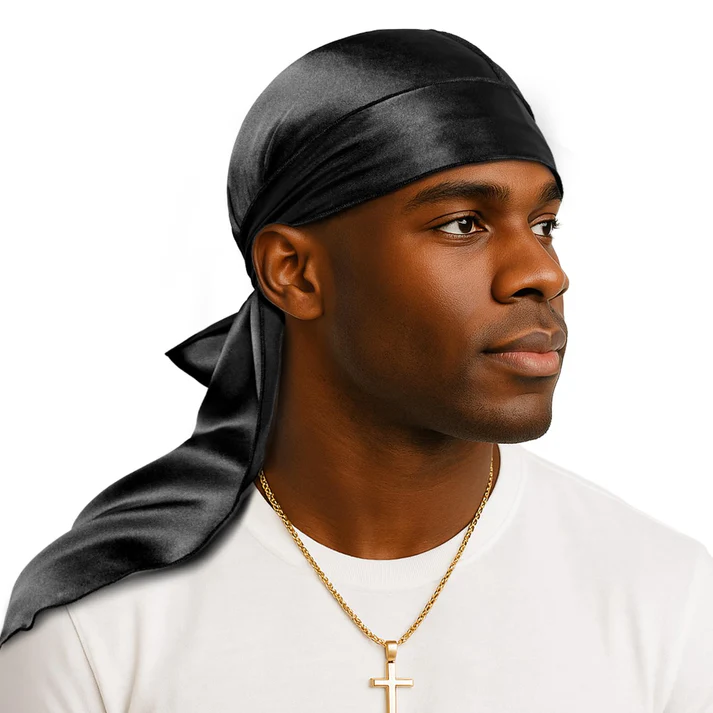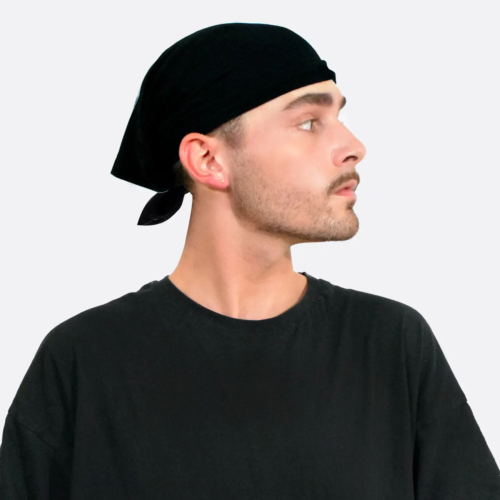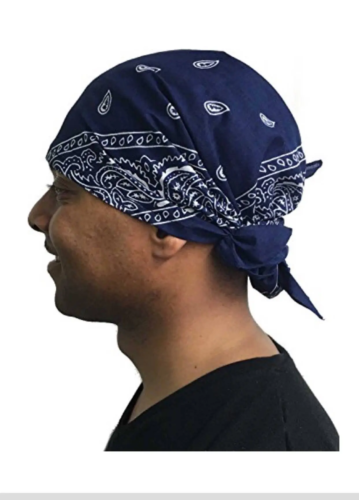If you’ve ever worn a durag or considered trying one, you might have wondered: can wearing a durag cause hair loss? It’s a common concern — especially if you use one regularly to protect your hairstyle, keep your hair smooth, or even as a fashion statement.
Durags have long been a key part of hair care routines, particularly among people with curly or textured hair. They help maintain waves, reduce frizz, and protect styles overnight. But in recent years, they’ve also become a popular fashion accessory, worn not just for function but for style too.
Still, with all the benefits, some wearers worry that putting on a durag every day might be doing more harm than good — especially when it comes to hair loss.
So, what’s the real story? In this article, we’ll take an in-depth look at whether wearing a durag can lead to hair loss. We’ll break down the science, explain how improper use might affect your hairline, and most importantly — show you how to wear a durag safely without risking your hair health.
By the end, you’ll know exactly what role a durag plays in your hair care routine — and how to make sure it supports, rather than harms, your hair goals.

Table of Contents
Toggle3. Understanding Hair Loss: Common Causes You Should Know
If you’re concerned that wearing a durag might be causing your hair to thin or fall out, it’s important to first understand the most common reasons people experience hair loss. In many cases, what you’re seeing may not be related to your durag at all — but rather to other underlying factors.
1. Genetic Predisposition (Androgenetic Alopecia)
One of the most common causes of hair loss is genetics . Known as androgenetic alopecia , this condition affects both men and women and typically presents as a receding hairline or thinning crown. If your parents or grandparents experienced hair loss, there’s a good chance you might too — regardless of whether you wear a durag or not.
2. Hormonal Changes
Hormones play a major role in hair growth and shedding. Fluctuations due to pregnancy, menopause, thyroid issues , or even stopping birth control pills can lead to temporary or long-term hair thinning. These hormonal shifts can disrupt your hair’s natural growth cycle, leading to increased shedding.
3. Poor Lifestyle Habits
Your daily habits can also impact your hair health. Things like:
- Poor nutrition (especially low protein or iron intake)
- High stress levels
- Lack of sleep
- Smoking
- Dehydration
…can all contribute to weakened hair follicles and increased hair loss over time. Improving these lifestyle factors can often make a noticeable difference in hair thickness and regrowth.
4. Physical Tension on the Hair (Traction Alopecia)
Now, this is where wearing a durag could potentially come into play — but only if worn improperly. Traction alopecia is a form of hair loss caused by repeated pulling or tension on the hair follicles. It’s commonly seen in people who frequently wear tight hairstyles like braids, ponytails, weaves, or extensions.
If a durag is worn too tightly for extended periods , especially around the hairline, it can create enough friction and pressure to weaken hair follicles — particularly in sensitive areas like the temples and forehead.
However, it’s crucial to note that traction alopecia usually results from long-term, consistent strain , not occasional or properly worn durags.
4. Does Wearing a Durag Cause Hair Loss? A Scientific Look
You may have heard rumors that wearing a durag can lead to hair loss — especially around the hairline. But what does the science really say?
As of now, there is no conclusive scientific evidence that wearing a durag directly causes hair loss in most people. In fact, when used correctly, a durag can actually help protect your hair from damage by reducing frizz and keeping your style intact.
However, just like with any headwear or hairstyle that puts pressure on your scalp, how you wear your durag matters . Let’s break down the key factors that could potentially affect your hair health when using a durag.
1. Wearing It Too Tight – The Risk of Traction Alopecia
The biggest concern isn’t the durag itself — it’s how tightly you wear it.
If you consistently wear your durag pulled too tight , especially around the edges or hairline, it can create constant tension on your hair follicles. Over time, this repeated pulling may contribute to a condition called traction alopecia — a form of hair loss caused by long-term stress on the hair follicles.
This type of hair loss usually starts subtly — maybe you notice your hairline receding slightly or thinning along the temples. If not addressed early, it can become permanent.
So ask yourself:
👉 Do you feel pressure or tightness after tying your durag?
👉 Does your hairline look thinner after weeks or months of regular use?
If the answer is yes, it might be time to reconsider how you’re wearing it.
2. Fabric Type – How Your Durag Material Affects Hair
Not all durags are created equal — and the material you choose can make a big difference in how your hair responds over time.
- Cotton durags , while breathable, can be rough on your hair and cause more friction.
- Silk or satin durags , on the other hand, are much smoother and gentler on both your hair and scalp.
Using a harsh fabric that constantly rubs against your strands can increase breakage and dryness — especially if you wear your durag for long periods or while sleeping.
3. Lack of Cleanliness – Why You Should Wash Your Durag Regularly
Another often-overlooked factor is hygiene. If you wear the same unwashed durag every day, it can collect:
- Sweat
- Oils
- Dead skin cells
- Bacteria
Over time, this buildup can clog your hair follicles and irritate your scalp — which may indirectly impact hair growth and even lead to dandruff or infections.
To avoid this, aim to wash your durag at least once a week, especially if you wear it daily.
5. How to Wear a Durag Safely — Protect Your Hair Without Causing Damage
If you want to enjoy the benefits of wearing a durag without risking hair loss, it all comes down to how you use and care for it.
The good news is that with just a few simple adjustments, you can protect your hairstyle and keep your scalp healthy at the same time. Here’s how to wear a durag safely and reduce the risk of hair damage or thinning:
✅ Choose the Right Material – Go for Silk or Satin
Not all durags are created equal — and the fabric you choose can make a big difference in how your hair responds over time.
- Cotton durags may feel soft to the touch, but they can create more friction against your hair, leading to breakage.
- Silk or satin durags , on the other hand, are much smoother and help reduce hair friction and moisture loss.
Wearing a silk or satin durag while sleeping can also help preserve your curls or waves and prevent dryness — making them a better long-term option for hair health.
✅ Don’t Pull It Too Tight – Avoid Tension on Your Hairline
One of the most common ways a durag can cause hair loss is by pulling too tightly on your scalp — especially around the edges.
Over time, this tension can weaken your hair follicles and lead to a condition called traction alopecia , which causes gradual thinning or bald spots.
So ask yourself:
- Does your head feel tight or uncomfortable after tying your durag?
- Do you see pressure marks on your forehead when you take it off?
If the answer is yes, it’s a sign you’re wearing it too tight. A properly worn durag should stay in place without causing pain or leaving deep impressions.
✅ Limit How Long You Wear It – Give Your Scalp a Break
While durags are great for keeping your hair looking fresh, wearing one for hours on end isn’t ideal for your scalp.
Your skin needs airflow to stay healthy. Wearing a durag all day can trap sweat and oils, potentially irritating your scalp or clogging hair follicles.
💡 Tip: Try not to wear your durag for more than a few hours a day. If you’re using it while sleeping, take it off first thing in the morning to let your scalp breathe.
✅ Wash Your Durag Regularly – Keep It Clean for Healthy Hair
You probably wash your pillowcase regularly — so why not your durag?
Every time you wear it, your durag picks up:
- Sweat
- Oils
- Dead skin cells
- Bacteria
If left unwashed, these buildups can transfer back onto your scalp and contribute to issues like dandruff, irritation, or even infections.
To avoid this:
- Wash your durag at least once a week
- Use a mild detergent to avoid harsh chemicals
- Air-dry if possible to preserve the fabric
Keeping your durag clean helps ensure your hair and scalp stay in top shape.
✅ Pair It With the Right Hair Products – Support Hair Health
Using the right products before putting on your durag can give your hair an extra layer of protection.
Before wearing your durag:
- Apply a light leave-in conditioner or hair oil to seal in moisture
- Use edge control sparingly — too much buildup can irritate your scalp
- Consider using a silk bonnet under your durag for added protection
These small steps can go a long way in preventing dryness, breakage, and scalp irritation — helping you maintain healthier hair in the long run.
5. How to Wear a Durag Safely — Protect Your Hair Without Causing Damage
If you want to enjoy the benefits of wearing a durag without risking hair loss, it all comes down to how you use and care for it.
The good news is that with just a few simple adjustments, you can protect your hairstyle and keep your scalp healthy at the same time. Here’s how to wear a durag safely and reduce the risk of hair damage or thinning:
✅ Choose the Right Material – Go for Silk or Satin
Not all durags are created equal — and the fabric you choose can make a big difference in how your hair responds over time.
- Cotton durags may feel soft to the touch, but they can create more friction against your hair, leading to breakage.
- Silk or satin durags , on the other hand, are much smoother and help reduce hair friction and moisture loss.
Wearing a silk or satin durag while sleeping can also help preserve your curls or waves and prevent dryness — making them a better long-term option for hair health.
✅ Don’t Pull It Too Tight – Avoid Tension on Your Hairline
One of the most common ways a durag can cause hair loss is by pulling too tightly on your scalp — especially around the edges.
Over time, this tension can weaken your hair follicles and lead to a condition called traction alopecia , which causes gradual thinning or bald spots.
So ask yourself:
- Does your head feel tight or uncomfortable after tying your durag?
- Do you see pressure marks on your forehead when you take it off?
If the answer is yes, it’s a sign you’re wearing it too tight. A properly worn durag should stay in place without causing pain or leaving deep impressions.
✅ Limit How Long You Wear It – Give Your Scalp a Break
While durags are great for keeping your hair looking fresh, wearing one for hours on end isn’t ideal for your scalp.
Your skin needs airflow to stay healthy. Wearing a durag all day can trap sweat and oils, potentially irritating your scalp or clogging hair follicles.
💡 Tip: Try not to wear your durag for more than a few hours a day. If you’re using it while sleeping, take it off first thing in the morning to let your scalp breathe.
✅ Wash Your Durag Regularly – Keep It Clean for Healthy Hair
You probably wash your pillowcase regularly — so why not your durag?
Every time you wear it, your durag picks up:
- Sweat
- Oils
- Dead skin cells
- Bacteria
If left unwashed, these buildups can transfer back onto your scalp and contribute to issues like dandruff, irritation, or even infections.
To avoid this:
- Wash your durag at least once a week
- Use a mild detergent to avoid harsh chemicals
- Air-dry if possible to preserve the fabric
Keeping your durag clean helps ensure your hair and scalp stay in top shape.
✅ Pair It With the Right Hair Products – Support Hair Health
Using the right products before putting on your durag can give your hair an extra layer of protection.
Before wearing your durag:
- Apply a light leave-in conditioner or hair oil to seal in moisture
- Use edge control sparingly — too much buildup can irritate your scalp
- Consider using a silk bonnet under your durag for added protection
These small steps can go a long way in preventing dryness, breakage, and scalp irritation — helping you maintain healthier hair in the long run.
7. Frequently Asked Questions (FAQ) About Durags and Hair Loss
Here are some of the most common questions people ask about wearing durags and how they may affect hair health:
❓Q: Can Wearing a Durag Make Me Bald?
In most cases, no — wearing a durag will not make you bald. However, if you consistently wear it too tightly for long periods, especially around your hairline, it can cause traction alopecia , a form of hair loss caused by repeated pulling on the hair follicles.
The key is to wear your durag comfortably — snug enough to stay in place, but not tight enough to leave marks or cause discomfort.
❓Q: Is It Safe to Sleep in a Durag?
Yes, sleeping in a durag can be safe — and even beneficial — as long as you do it right.
A durag can help protect your hairstyle, reduce frizz, and keep your hair smooth overnight. But to avoid damaging your hair:
- Choose a silk or satin durag (they’re gentler on your hair)
- Don’t tie it too tight
- Take it off first thing in the morning to give your scalp a break
If you’re concerned about hair loss, consider using a satin pillowcase or a satin bonnet instead — they offer similar benefits with less pressure.
❓Q: How Do I Know If My Durag Is Too Tight?
Wearing a durag that’s too tight is one of the main causes of hairline damage. Here are some signs that your durag might be pulling too hard:
- You feel pressure or tightness after tying it
- Your forehead is marked or indented when you take it off
- Your hairline feels sore or tender
- You notice thinning along your edges over time
If any of these apply to you, it’s time to adjust how you tie your durag — aim for a snug fit without tension or pain.
❓Q: What Material Is Best for Preventing Hair Damage?
When it comes to protecting your hair, silk or satin durags are your best bet.
These materials:
- Reduce friction and hair breakage
- Help retain moisture in your hair
- Are gentle on your scalp and edges
Cotton durags, while breathable, can be rougher and more likely to cause dryness or frizz — especially if you sleep in them.
For optimal protection, choose a satin-lined durag or pair your durag with a silk bonnet underneath.



